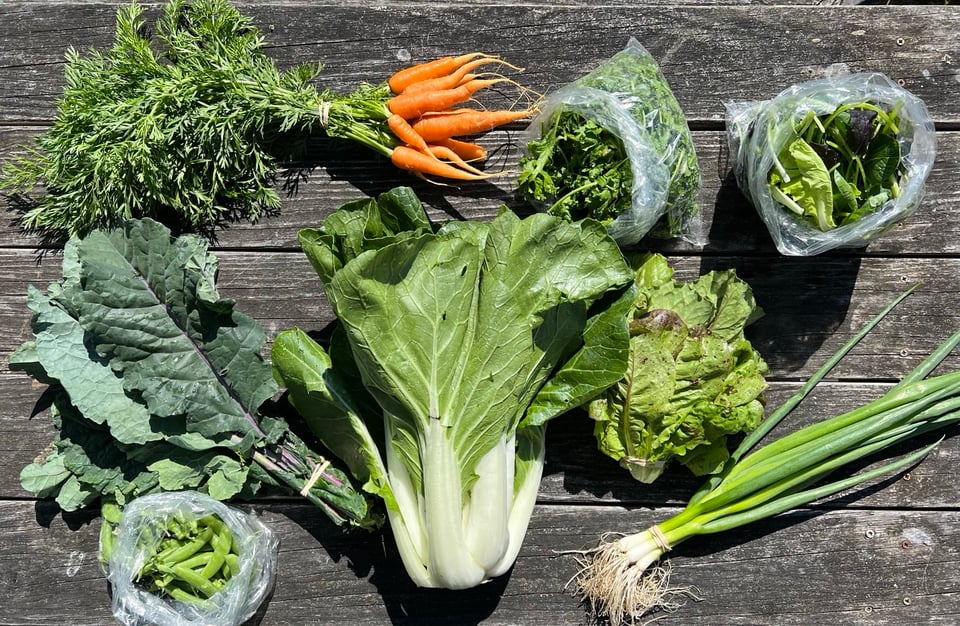CSA Week 4: Snap Peas!

Tian Tian Farm Newsletter - June 19, 2024

Logistics:
Another reminder that we will not be delivering shares the week of July 1 to 7. Deliveries will commence the following week.
This Week’s Share (From L to R, top to bottom):
Carrots
Gaden cress
Stir fry mix
Lacinato kale
Bok choy
Head lettuce
Sugar snap peas
Scallions
Our first carrot harvest is a small one to thin out our beds. The idea is to encourage growth, so hopefully we’ll have big carrots in a week or two.
Garden cress has a wasabi-like, sinus-clearing spice. We like to throw it in salad.
We’ve held out on growing kale and finally gave in this season. It’s just too damn resilient and productive.
More bok choy and lettuce to clear out existing beds.
This is our first big sugar snap pea harvest of the season! In my opinion, the early peas are the sweetest.
And we’ll try to make scallions a fixture of sorts going forward.
Weeds
We spent much of our first season pulling grass. The acre currently hosting Tian Tian Farm was covered in sod. (At the time, we only cultivated 2/3 of that acre. The other third was managed by two sisters who have since moved off the island.) We hired our neighbor to till the land with his tractor, turning the field from green to brown. Unfortunately for us, the grass on our land is crabgrass, a rhizomal variety whose root matter continued to produce more crabgrass. And so, we spent much of the first season pulling grass.
By our second season, we had mostly fought back the crabgrass, inviting a whole new crop of weeds to Tian Tian Farm. Like crabgrass, sheep sorrel spreads subterraneously with thread-like roots. Its greens are slightly lemony, and we once put it in our stir-fry mix until we learned that it goes bad much quicker than our spring greens. Pigweed plucks right out of the ground, but grows rapidly and multiplies exponentially, and we’ve far too often missed a plant that’s gone to seed. It’s actually a variety of amaranth, for which we grow a culinary variety that’s a big hit with Chinese grandmothers. Purslane is an edible succulent that carpets the soil with its tentacle-like branches. If it gets out of control, we harvest it, as last year’s CSA members will recall. Dock grows an incredibly deep and stubborn root that requires a fair amount of elbow grease to remove. We battle several species of thistle with varying degrees of prickliness, invasiveness, and noxiousness. On the south side of the field, where the sisters used to farm, two climbing weeds have thrived. Of the two, bindweed is the bigger problem, due to its extensive, nearly impossible to remove root system. Above ground, morning glory grows similarly to bindweed (that is, as a vine that will spiral up anything it can find), but thankfully, its roots will pop right out like pigweed. On the edges of our farm, like everyone else in western Washington, we face the scourge controlled invasive species such as Himalayan blackberry, Scotch broom, common ragwort, and to a lesser, but more urgent extent, tansy ragwort.
This is an incomplete list, as there are many weeds that I have forgotten or have yet to identify.
In an ideal world, we would get to all of these weeds before they become a problem. And we try. We use a colinear hoe to slice through them in our vegetable beds, carefully weaving between our crops. We bulldoze down the aisles with our stirrup hoe. Sometimes we even use our flameweeder to torch them at what’s known as the “thread-stage,” before they’ve had a chance to settle. When we known we won’t be planting in an area for a while, we’ll cover the ground with silage tarps or landscaping fabric, smothering and suffocating existing weeds, and hopefully preventing new ones from establishing.
As a last resort, we’ll hand-weed. If we’re on top of things, hand-weeding will be kept to a minimum. If we’re behind, hand-weeding becomes more urgent. Right now, as we’ve expanded our operations, we’ve fallen really, really behind on the weeding. My back already hurts when I think about the weeds we’ve let go to seed.
Recipe: Hot Pot

The heat wave is coming, and my aunties say eating hot food when it’s hot out is good for digestion. I’m not sure how much I believe that, but Elizabeth’s cousin was in town this week and we had a lot of vegetables in our fridge, as well a big slab of frozen pork belly. Sometimes, when we want to impress a guest, but also want to clear our fridge, we whip out the mini hot pot that my parents gifted me a couple years ago.
Ingredients:
Hot plate and pot (or a specialty hot pot)
Liquid base (stock with spices or buy a packet from an Asian grocery store. We used this one this week).
Tian Tian Farm vegetables
Anything else you want (very thinly-sliced meat, mushrooms, ramen noodles, tofu, fish balls, etc.)
Sauce (we use shacha sauce combined with sesame paste, hot oil, an egg yolk, and minced garlic and ginger)
Directions:
Call your friends.
Mix sauce.
Get your pot to a roiling boil. Keep it at a low boil.
Dip food in pot.
Dip food in sauce.
Enjoy.
‘Til next time,
Steven
